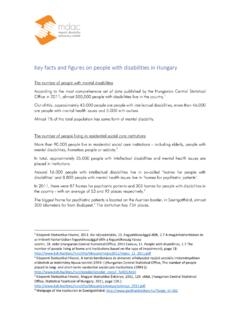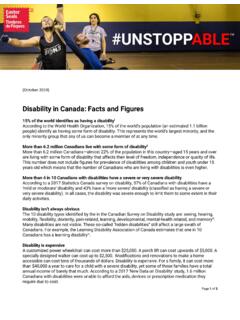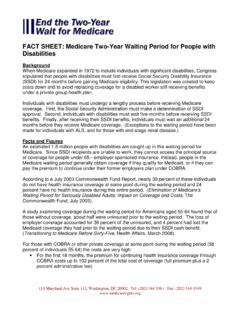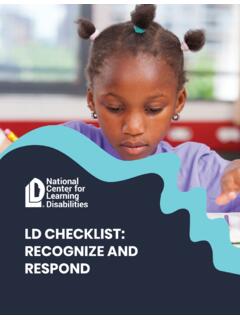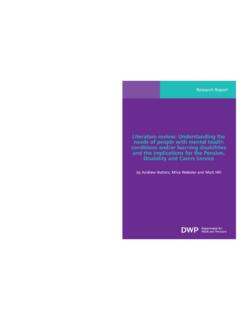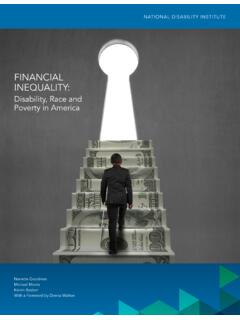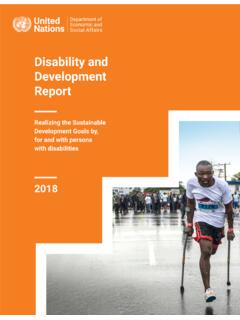Transcription of Papworth Trust Disability Facts and Figures 2018
1 FiguresDisability in the United KingdomFacts and2018 ContentsForeword 4 Methodology 5 Key Statistics 6 Class/Income and Poverty 8 Age 11 Gender 12 Ethnicity & Geography 13 Hearing 15 Sight Loss 17 Mental Health 18 Children 20 Learning Disabilities 22 Carers 25 Social Care 28 Employment 32 Education 38 Transport 40 Housing 42 Accessibility 48 References 51 PageSection01020304050607080910111213141 516171819202301480 357 200 to the eighth edition of Papworth Trust s Disability Facts and Figures .
2 This includes information on the key areas of disabled people s lives and outlines the challenges they face every single day. We hope that you find this report both useful and line with Papworth Trust s priorities, this year s edition pays particular attention to employment, social care and housing, our key policy areas. We believe they hold the greatest inequality for disabled people and are therefore the areas that require the greatest socio-economic and political change. Through the services provided by Papworth Trust , we work hard to support disabled people to have equality, choice and independence in their daily lives. This year s edition includes a new chapter on Carers, exploring the challenges the current care funding crisis brings and the impact on individuals who provide unpaid and Figures is designed to inform, initiate and encourage debate around the key issues affecting disabled people .
3 If you would like more information or wish to provide us with any feedback, please contact us on Rob HammondChair 01 ForewordMethodology02 This report gives an overview on the most recent Facts and Figures about Disability in the United Kingdom today. It covers the key policy areas that Papworth Trust focuses on, including employment, social care and also covers key areas including education, transport and accessibility as well as well as the prevalence of specific impairments. This report is a result of a comprehensive search into the latest statistics on all aspects of Disability . It uses information from the most recent surveys and reports, as well as data derived from other charities.
4 We believe that information from a variety of different sources will help capture the breadth of issues affecting disabled is important to note that the different sources are not necessarily compatible and that the data may be based on different definitions. However, most of the information in this report has been provided in line with the Equality Act 2010 definition, which states: A person has a Disability if: They have a physical or mental impairment The impairment has a substantial and long-term adverse effect on their ability to perform normal day-to-day 357 200 Statistics Class, Income & Pay Full-time disabled workers earn on average less ( 75 a week) than full-time non-disabled people .
5 1 There are million disabled people living in poverty, which is 29% of all people living in poverty. 2 Gender There are more disabled women than men in the UK (23% compared to 19%). 3 Location In 2016, Wales had the highest percentage of disabled people (26%). 4 London had the lowest percentage of disabled people (14%). This is equivalent to million disabled people . 5 Hearing Hearing loss increases with age. More than 70% of over 70 year olds and 40% of over 50 year olds have some form of hearing loss. 6 Sight Loss Every day in the UK, 250 people start to lose their sight. 7 The number of people living with sight loss will increase to more than million in 2030 and four million in 2050.
6 8 Mental Health By 2030, there are expected to be two million more adults with mental health problems than in 2013. 9 50% of mental health problems are established by age 14 and 75% by age 24. 10 Children 7% of children in the UK are disabled and 10% of children in the UK live in a family with at least one disabled child. 11 It costs three times more to raise a disabled child, as it does to raise a non-disabled child. 12 03 Carers There are around 7 million carers in the UK, this is equivalent to 1 in 10 people . 13 In the UK, 3 in 5 people will be carers at some point in their lives. 14 Social Care Carers are currently providing care worth 132 billion a year, the equivalent to the UK s total healthcare annual spend, and over two million people have already given up work to care.
7 15 Disabled people between the ages of 18-65 represent one third of social care users. The social care funding gap the gap between costs and revenue is projected to reach by 2019/20. 16 Employment Disabled people are twice as likely to be unemployed than non-disabled people . 17 By the age of 26, disabled people are four times more likely to be out of work or not in education, compared to non-disabled people . 18 Early intervention is key to prevent people from falling out of work. 19 1 in 5 employers say they would be less likely to employ a disabled person. 20 Education Disabled young people aged 16-18 were at least twice as likely as their non-disabled peers to not be in education, employment or training.
8 21 The proportion of disabled people with no qualifications is nearly three times that of non-disabled people . 22 Transport The main modes of transport for people with a mobility difficulty are: - Driving (38%) - Being a passenger in a car (30%) - Walking (16%) - Bus (9%) - Other (8%). 23 Housing There are million disabled people with unmet housing needs, 580,000 of whom are of working age. 24 As a result of unmet housing needs for accessible housing, disabled people are four times more likely to be unemployed or not seeking work. 25 Two thirds of single disabled people living alone are in poverty. 26 Accessibility The most commonly reported difficulties for disabled people in accessing goods and public services: - Shopping (20%) - Cinema/theatre/concerts (15%) - Pubs and restaurants (14%).
9 27 6701480 357 200 Wage Gap and Income Disabled people who are in employment often face a significant pay On both relative and absolute low income measures, those living in a family with a disabled member are more likely to be in low income than non-disabled families. 32 Full-time disabled workers earn on average less ( 75 a week) than full-time non-disabled people . 33 Disabled people working part-time earn on average less ( 30 a week) than part-time non-disabled workers. 34 Disabled people are more likely to be in low-paid jobs than non-disabled people . 35 30% of disabled men and 35% of disabled women are paid below the living wage compared with 25% of non-disabled men and 29% of non-disabled women.
10 36 Among types of impairment, the largest proportion of workers paid below the living wage (about 35%) is those with a mental The pay gaps for those with physical impairments are also substantial. Men with physical impairments generally experience pay gaps in the range of 15% to 28%, depending on the nature of the The difference between non-disabled women s pay and that of women with physical impairments ranges from 8% to 18%. 39 Living Standards The spending power of families with at least one disabled person is estimated by the Government to be over 200bn a year. 40 Disabled people s day-to-day living costs are 25% higher than those of non-disabled people .
